Alsace Wines Shine with Summer’s Bounty Risotto #Winophiles
French Winophiles Love Alsace
Our French Winophiles writers love Alsace, but it’s been a while since our last official virtual visit. We’re excited to be returning this month with our latest discoveries from the region. Scroll further down in this post for a list of links to all our fellow writers’ posts.
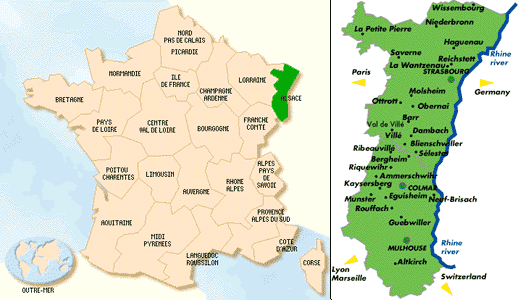
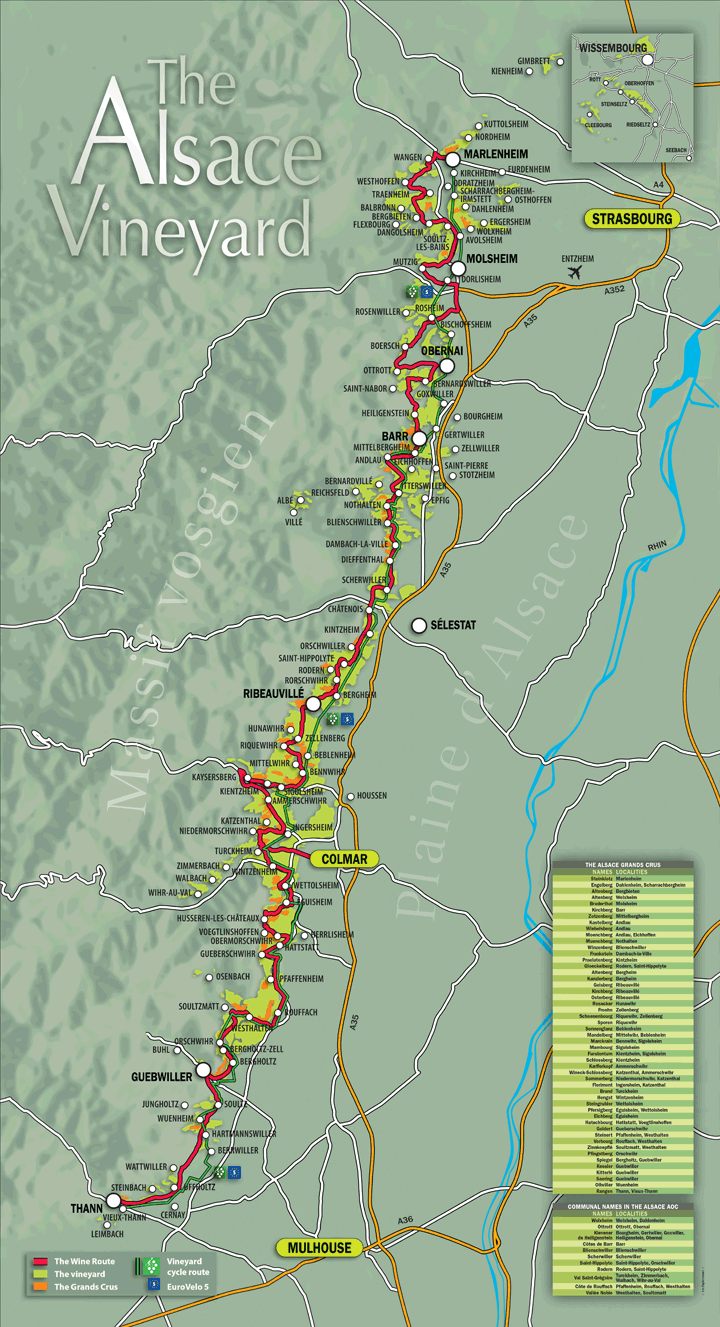
Alsace is Unique
Terroir is a very popular topic among wine enthusiasts today. In simplest terms, it’s a wine showing “somewhere-ness”. That is, can a wine show a little bit about where it comes from. Alsace provides a great example of terroir at a regional level, and of course, smaller plots of land can further show their individual natures. Look at the map on the left above, you’ll notice Alsace is far north in France, similar to Champagne. This is at the northern limit of where grapes will successfully ripen. Looking at the map on the right, you’ll notice the wine region is immediately to the east of the Vosges Mountains.
(click on any photo for full size slide show, hit close to exit)
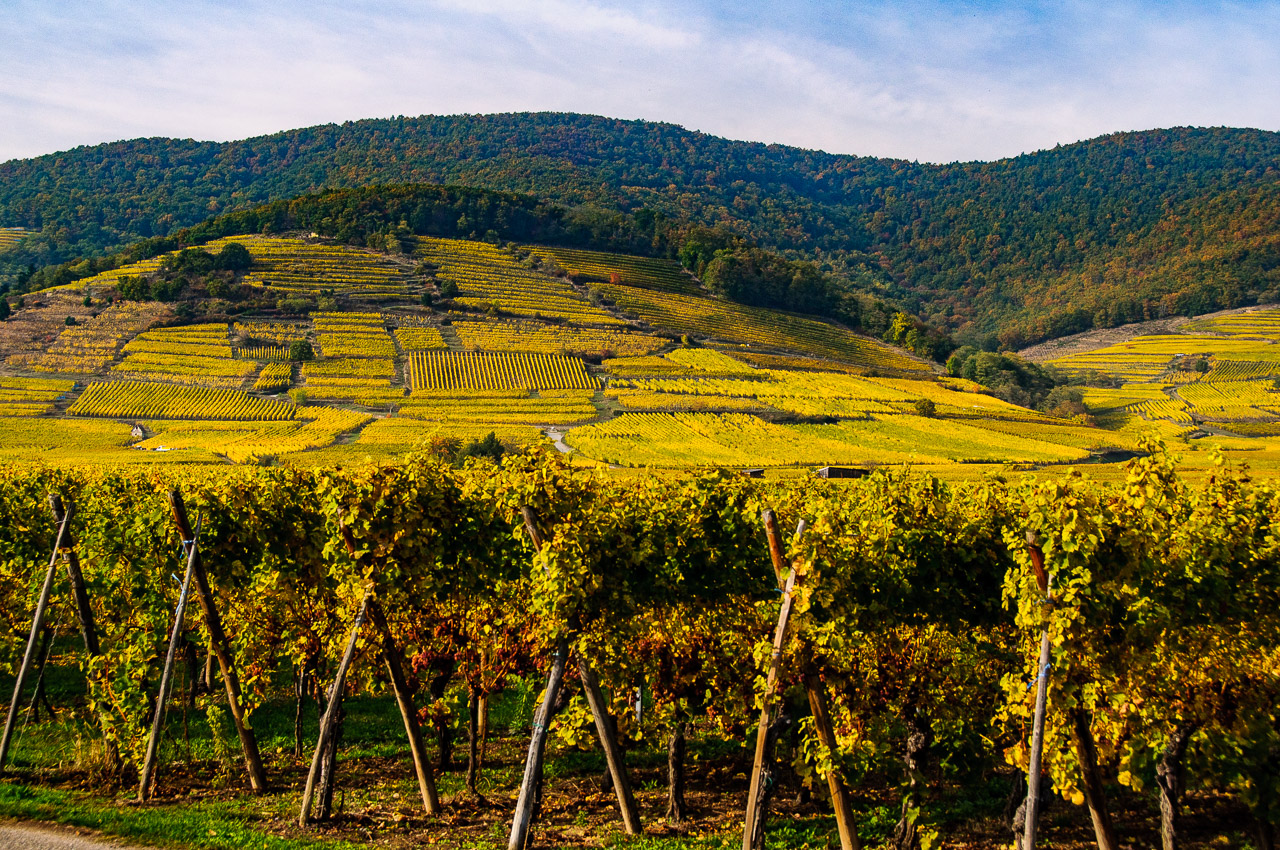
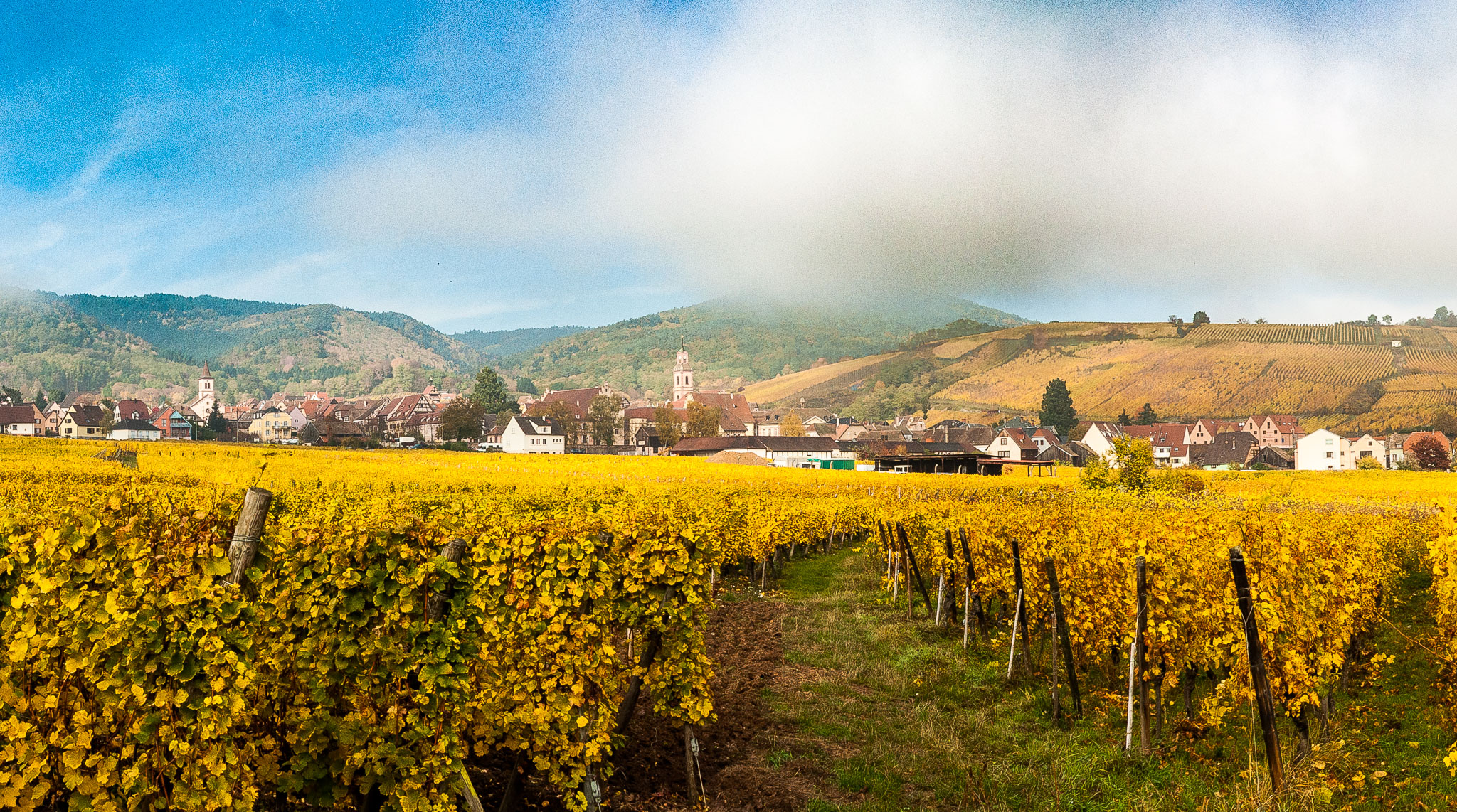
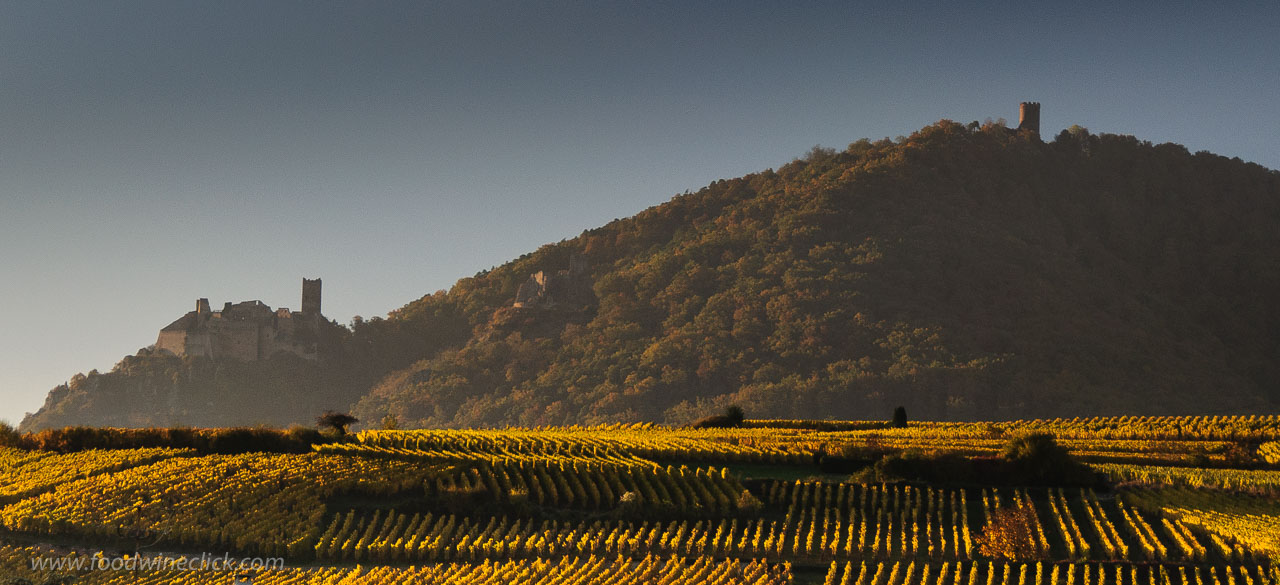

In fact, most vineyards are located on slopes facing east and southeast. These slopes allow the vineyards to take advantage of every bit of sunshine. The whole region sits in the rain shadow of the Vosges Mountains, and the dry climate extends the growing season well into the autumn. All these factors translate to:
- Cool climate white wines, though some Pinot Noir is grown
- Riesling is one of the main grapes as it does well in cool climates, though it needs a long season to ripen fully.
- The long, dry fall in Alsace brings fuller body and higher alcohol compared to vineyards to the west in Champagne and to the east across the Rhine River in Germany.
- The dry conditions have encouraged growers to embrace organic and biodynamic viticulture, about 15% of Alsace vineyards are farmed to organic or biodynamic standards.
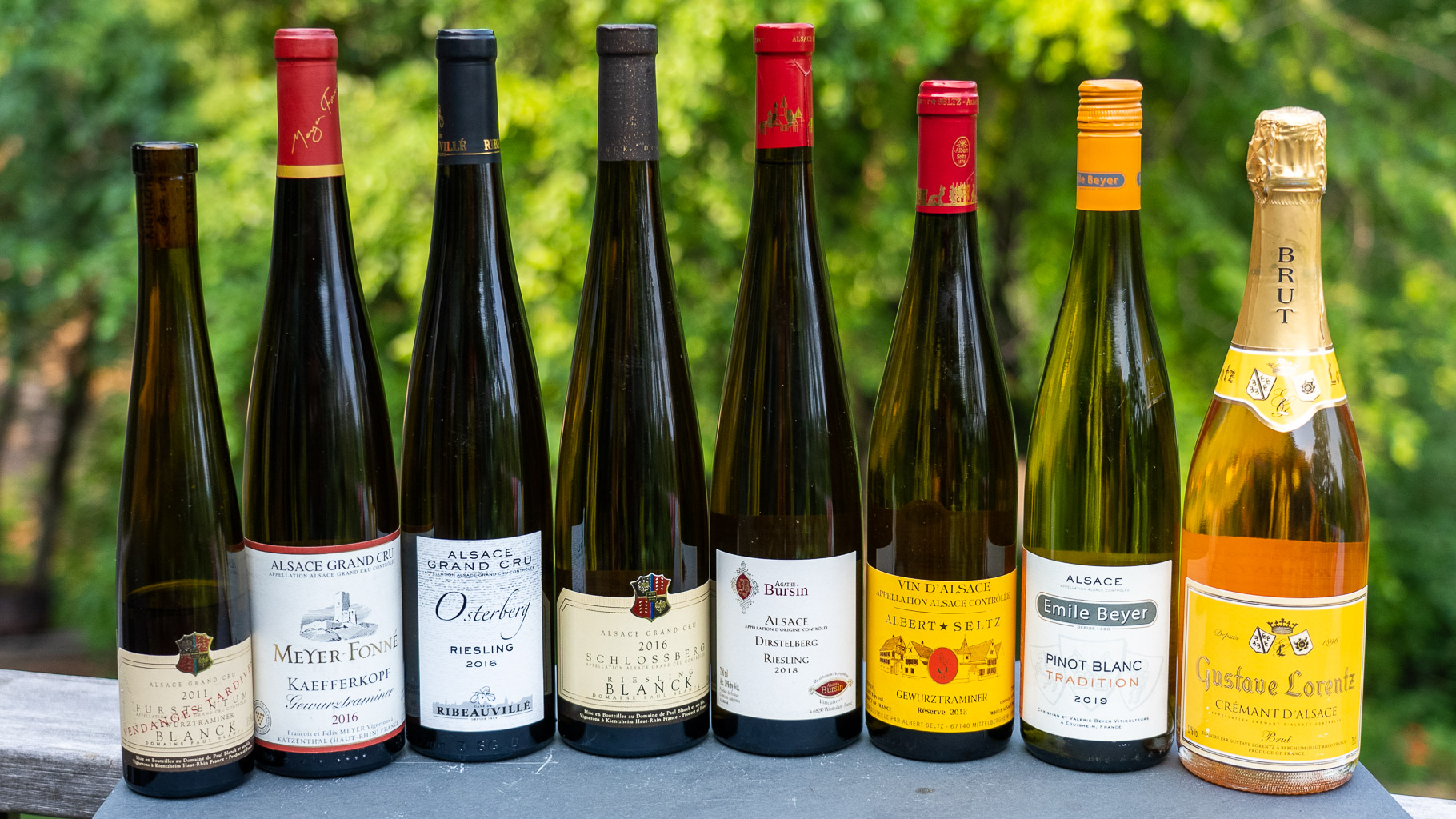
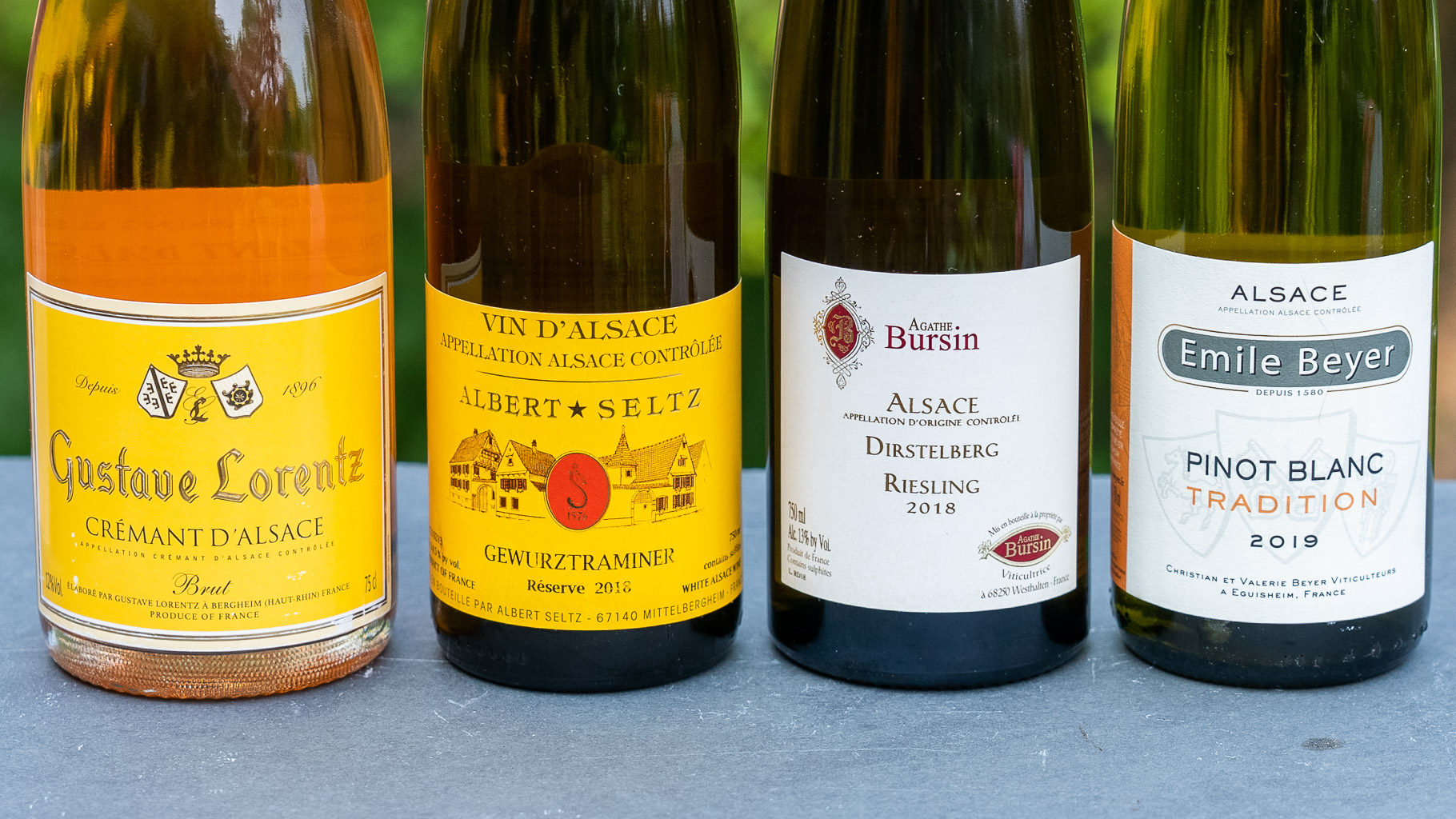
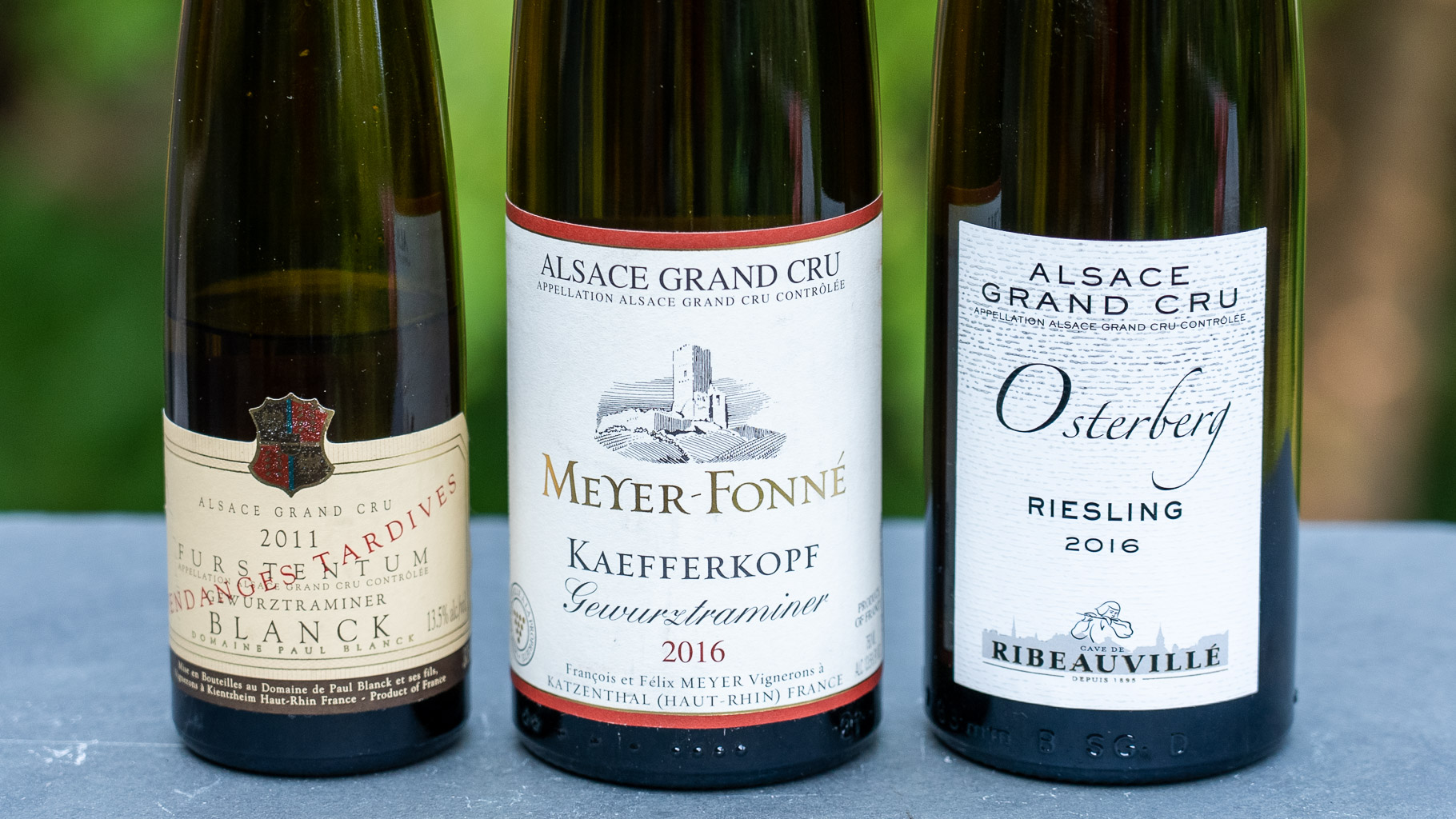
A Little More on Alsace Wines
There are a few more items of note in Alsace. Unlike most of the rest of France, the wines are labeled with the variety name, yay! The basic appellations for the region are easy: Alsace AOC and Crémant d’Alsace AOC. These wines can be made from Riesling, Pinot Blanc (aka Auxerrois), Gewurztraminer, Pinot Gris, Pinot Noir, Sylvaner, Muscat. The top echelon of wines are the Alsace Grand Cru wines. As simple as the basic appellations are, the Grand Crus are complicated. They must be made of one of the “noble” varieties: Riesling, Gewurztraminer, Pinot Gris, Muscat. The Grand Crus are single vineyards delineated by specific soil type, and there are 51 of them, each having their own named appellation! Finally, there are Vendanges Tardives (late harvest) and Sélection de Grains Nobles (SGN) classifications for late harvest sweet wines.
Disclosure: The wines for today’s post were provided as samples. No other compensation was involved, all opinions are mine. The scallops and spice were part of our Vital Choice seafood samples, previously reported here.

Agathe Bursin Riesling Dirstelberg AOX 2018 (sample, $35 online here) 13% abv
Eye: Pale lemon
Nose: Medium plus intensity aromas of lemon curd, ripe red apple, cantaloupe, smoke, flint, freshly cut garden hose
Mouth: Dry, high acidity, medium plus creamy body, medium alcohol, medium plus intensity flavors, medium plus finish with lingering tart lemon
Observations: Fascinating combination of high, tart acidity with medium plus body. Winemaking details are available here. Organic, biodynamic, no sulfur dioxide until bottling.
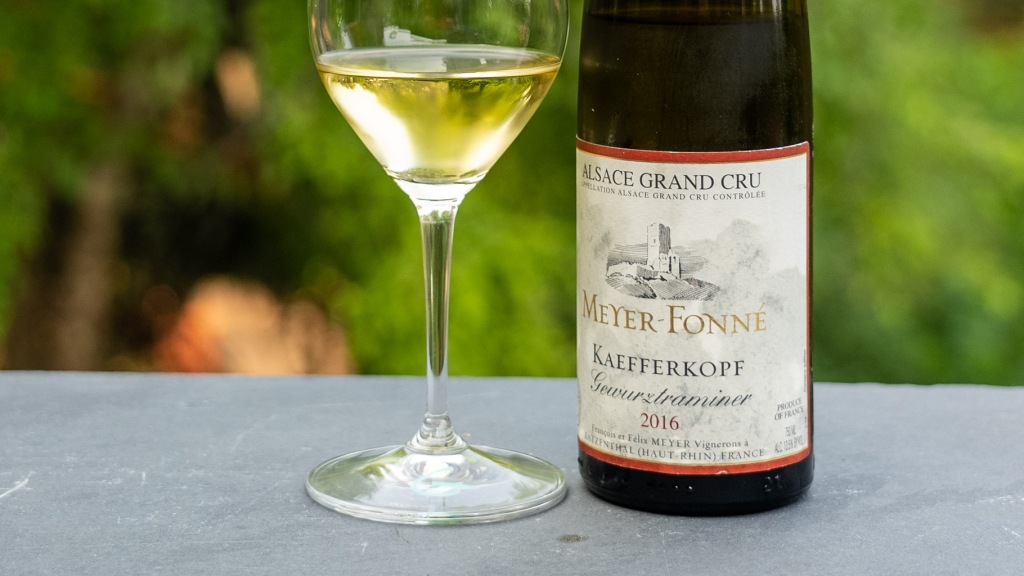
Meyer-Fonné Kaefferkopf Gewurztraminer Alsace Grand Cru AOC 2016 (sample, $37 online here) 13.5% abv
Eye: Medium lemon
Nose: Pronounced intensity aromas of honeysuckle, ripe lychee, mango, dragonfruit, pineapple, baking spice, musk
Mouth: Medium-dry, medium acidity, rich full body, medium alcohol, pronounced intensity flavors, long finish.
Observations: If you can get past the fact that Gewurztraminer is often sweet, and this one is, this is a delicious wine. Gewurztraminer has intense, exotic aromatics with rich texture, just beautiful.
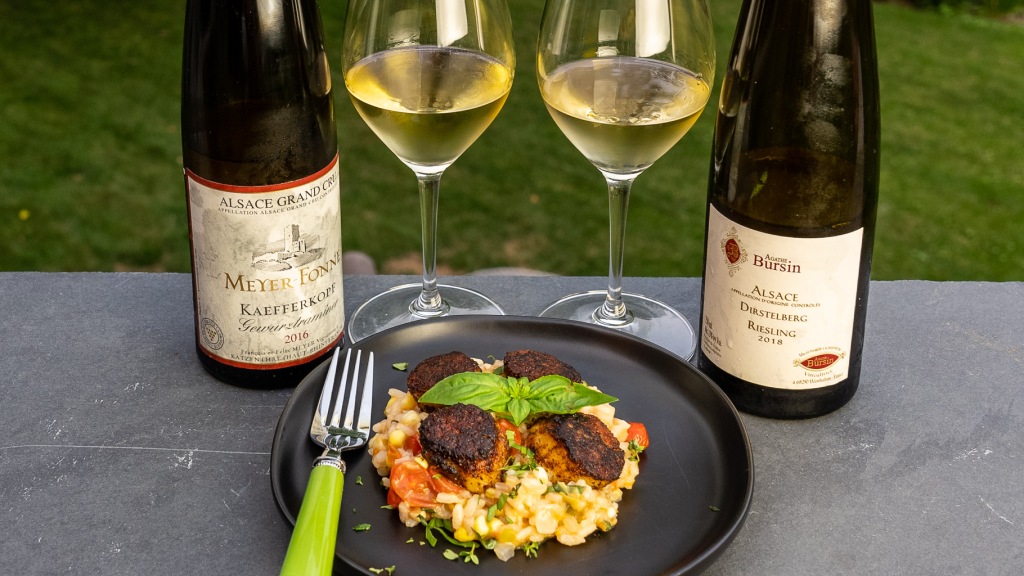
Alsace Riesling and Gewurztraminer with Blackened Sea Scallops with Summer Risotto
While Riesling and Gewurztraminer are both aromatic, they differ in sweetness, acidity, texture. I thought they both worked well with the scallops and risotto. Had the blackening spice on the scallops been more spicy hot, the sweetness in the Gewurztraminer may have had an edge in pairing.
French Winophiles Alsace Discoveries
Take a look at all the great ideas below from my fellow French Winophiles writers, then join our conversation! We meet on Saturday July 17 from 10-11am CDT on Twitter at the #Winophiles hashtag. We’d love to hear what you think!
- 3 Riesling from Alsace by Wine Predator…Gwendolyn Alley
- All About the Wines of Alsace by Vino Travels
- Alsace Wine and Cold Poached Salmon with Sauce Verte (Green Mayonnaise) by Our Good Life
- Alsace Wines’ Heart and Soul – Land Sustainability, Family Tradition and Food Compatibility by Chinese Food and Wine Pairings
- Alsace Wines Shine with Summer’s Bounty Risotto by Food Wine Click!
- Blending Innovation and Tradition with Wines of Alsace by L’Occasion
- Butternut Squash Chickpea Curry with Wine from Alsace by Cooking Chat
- Domaines Schlumberger 2018 Pinot Blanc: A Delectable Grape Mutation + Criques de Pommes de Terre by Culinary Adventures with Camilla
- Five Winemaking Women of Alsace by My Full Wine Glass
- Once Upon a Wine in Alsace by Wining With Mel
- Shrimp Louis Sandwiches paired with an Alsace Pinot Blanc by A Day in the Life on the Farm
- Summer Food Pairings with Alsace Wines by Always Ravenous
- Wines of Alsace Bring the Wow Every Time by What’s in that Bottle?
- Women of Alsace – Conversations with 4 Women on their Family Wineries in Alsace by Crushed Grape Chronicles
- Zind Humbrecht Pinot Blanc with a Leek & Bacon Tart by Somm’s Table
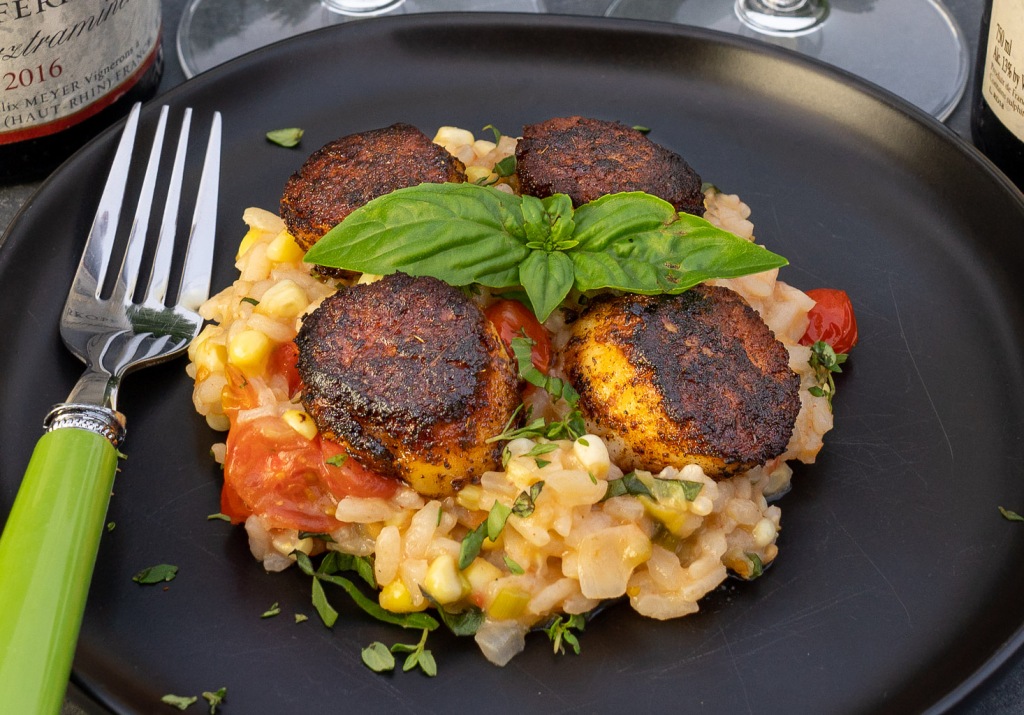
Summer's Bounty Risotto
Ingredients
- 1 Tbsp extra virgin olive oil
- 1 medium onion, chopped
- 8 oz. (1 cup) Arborio rice
- 1 cup white wine
- 3 medium tomatoes, grated on a coarse cheese grater, peels discarded
- 32 oz. chicken stock, heated to simmering in a pan
- 1 bunch fresh basil sliced thinly (chiffonade), about 1/4 cup loosely packed
- 3-4 sprigs of fresh thyme, stripped off the stems
- 3 ears of fresh sweet corn (uncooked), kernels cut off the cobs
- 2 oz. Parmigiano-Reggiano (use the real thing!) cheese, grated
- 8 oz. cherry tomatoes, halved
- 16 oz. sea scallops (from our sample Vital Choice seafood box)
- blackening spice mix (also from Vital Choice)
Directions
- Start by bringing the stock up to a simmer, just under boiling.
- Heat the olive oil in a pot large enough to hold the finished risotto, add the onions and cook until they are translucent, just a few minutes.
- Add the rice and continue cooking until the rice becomes slightly glossy and translucent. It will still be white in its center. This will only take 3-4 minutes.
- Add the white wine and stir. Adjust the heat to keep the liquid at high simmer, with occasional bubbles. Wait until the liquid is absorbed.
- After the liquid is absorbed, add a ladle of stock to the rice and stir. You don’t need to stir constantly. Some good advice: stir every time you take a sip of wine!
- Continue to add stock, 1 ladle at a time, allowing the liquid to be absorbed before adding another ladle. All the stock will be absorbed in about 20-30 minutes, but you’ll want to judge by tasting the nearly finished rice.
- With the early addition of the tomato sauce/juice, you may not need all the stock to achieve the desired firmness. Note that this is the point you choose how dry your risotto will be. Let it remain a little more liquid if you’re serving it in a bowl and you like a more soupy style. Let it absorb all the liquid if you prefer a more firm style which holds its’ shape on the plate.
- Fold in the Parmigiano-Reggiano and stir to melt
- Fold in the corn, cherry tomatoes, most of the basil and thyme, reserving a bit to sprinkle on top of the finished risotto.
- Scallops are seared in parallel with the last step of the risotto. Sprinkle the blackening spice on both sides just before placing in a cast iron skillet pre-heated to medium with just 1 Tbsp EVOO.
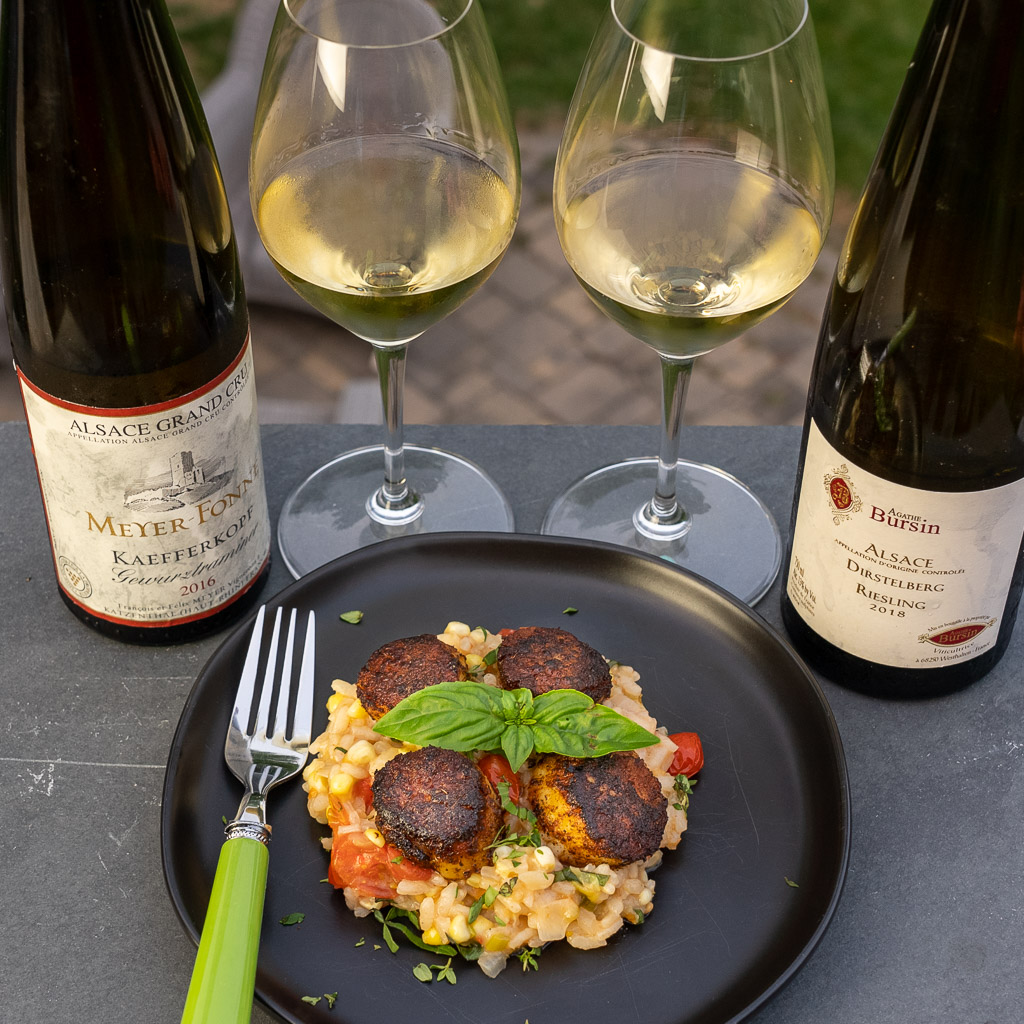
Comments
22 Responses to “Alsace Wines Shine with Summer’s Bounty Risotto #Winophiles”Trackbacks
Check out what others are saying...-
[…] Alsace Wines Shine with Summer’s Bounty Risotto by Food Wine Click! […]
-
[…] Alsace Wines Shine with Summer’s Bounty Risotto by Food Wine Click! […]
-
[…] Alsace Wines Shine with Summer’s Bounty Risotto by Food Wine Click! […]
-
[…] Alsace Wines Shine with Summer’s Bounty Risotto by Jeff Burrows at Food Wine Click! […]
-
[…] and fresh or what you might have on hand. Here’s a recent version of my go-to method for risotto. Fleurie is an excellent partner to spring dishes as it tends to be a bit lighter […]






This looks divine. We love a vegetable risotto at our house. I love your definition of terroir. I have been struggling with it and now I feel like I can address it better in my posts. Thank you!
Thanks Terri. Glad I could help in some small way!
I just made a risotto with peppers and zucchini last night. Now I wish I had topped it with scallops. Next times. Thanks for this post, Jeff. As always, my mouth is watering after reading your article.
Thanks Camilla. Scallops and risotto is a favorite of ours. In part because the scallops cook so quickly just as the risotto is finishing.
That risotto looks amazing Jeff. I love that you were able to contrast and compare a Riesling and a Gewurz. I had a wonderful chat (well…sort of a chat) with Agathe Bursin at the Digitasting. I will admit that 20cl bottles of her wine are most definitely not enough!
Thanks Robin. I agree, the bottles were just a little too small, barely a taste. Really fun to talk with the winegrowers 1:1 though.
Another great story, Jeff. I’m inspired to make your risotto (something I’ve struggled with) – still have two unopened bottles of Gewurz and Pinot Blanc to pair!
Thanks Liz. Risotto is worth working on!
Great recipe! Can see how ti would pari well with those wines. Yum!
oh and I love the maps!
Thanks Gwendolyn!
Riesling, Gewurztraminer and scallops…..al of my favorites. I was surprised I didn’t fall in love with my Gewurztraminer samples as I take a liking to that grape. I haven’t tried yours though.
Thanks Jen. I appreciate when a Gewurztraminer has enough acid to avoid seeming flat. Too many don’t quite make the grade.
What a delicious looking summer risotto. Nothing better than fresh summer produce from the farmers market paired with white wines of Alsace.
Thanks Jane. I agree!
What a delicious summer pairing Jeff!
I love Gewurtz, but the spouse finds it too perfumy for his tastes. Ah, well. More for me! Your pairings look spot on, as usual.